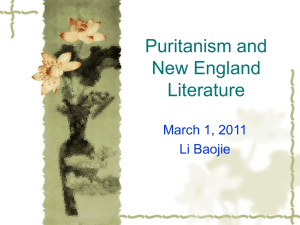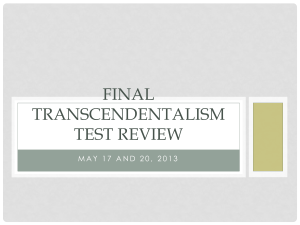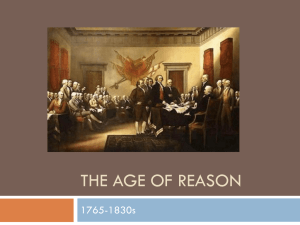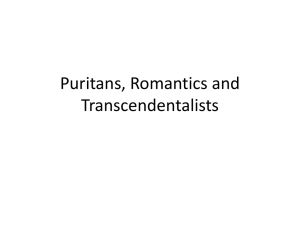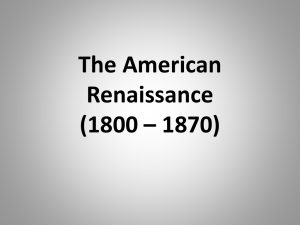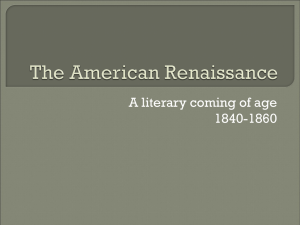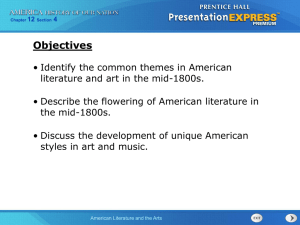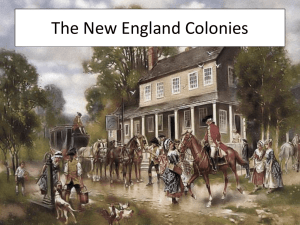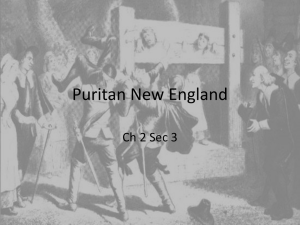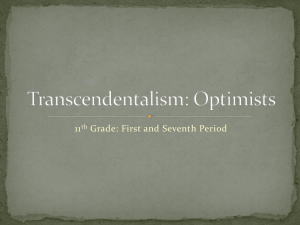Early America PPT
advertisement
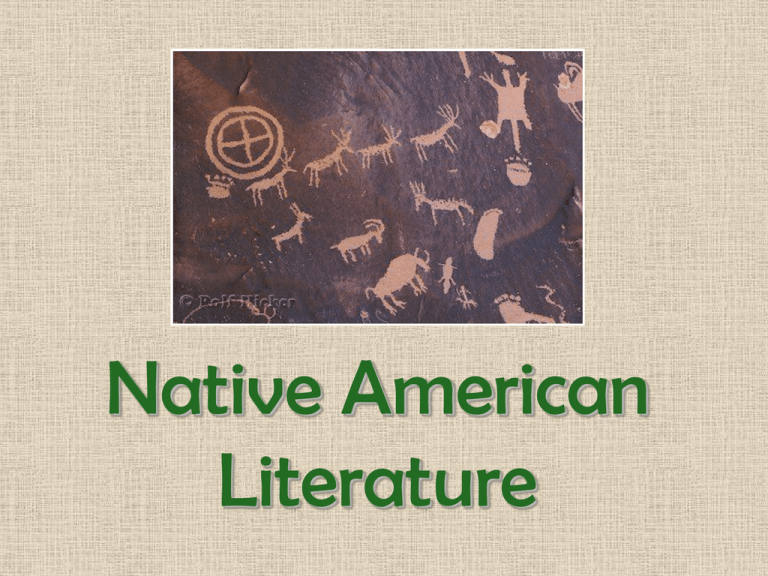
Native American Literature Native Americans and the Settlers (1490s – and on C.E.) • Dozens of unique American Indian tribes were scattered across North and Central America when the first colonists landed. The Aztec empire was by far the largest, with millions of natives within its borders. • The colonists and Indians had a relationship through trade that eventually lead to an interdependence between both groups. **How was each group dependent on the other? • Native Americans soon had to struggle to survive: disease epidemics, settlements overtaken by settlers and conquistadors, and mass extermination were all great threats. Belief Structure and Way of Life • There are differences between tribes, but all of the tribes have a strong ties to nature – typically having a Creator God and numerous spirits that often take on the form of animals or control the elements. NATURE IS CYCLIC. • Stories existed in the oral tradition. They were strongly tied to American Indian spirituality and tradition. Stories went hand-in-hand with ceremonial festivals, dance, costume, & music. • Creation, mythical hero, and trickster stories are the dominant story-types. The latter two often taught morals and lessons. Most tribes had their own unique story of creation. “The Sky Tree” • A creation myth of the Huron – a Native American people around the Great Lakes region. • The Earth Diver Myth – common among Northeast Native American cultures, this myth states that the earth was originally covered by water until some creature dives down to bring up a clump of earth which is placed upon the back of a great turtle, forming North America. *** • Review: What aspects of the settings in this myth are creation-story archetypes? What other mythological/religious stories have used the same archetypes? • What does the rooting of the tree represent? “Coyote Finishes His Work” • A story from the Nez Perce, a Native American people of the Plateau culture (Oregon and Washington area). *** • Review: What traits make Coyote a trickster archetype? • What aspects of life on earth are explained in this myth? • What metamorphoses (plural!) take place in this myth? • OPTIONAL BONUS: Read then illustrate and label a scene from “Black Elk Speaks” “The Sun Still Rises in the Same Sky” Review • 1. Why did scholars have problems recognizing the traditions of Native American literature? • 2. What three generalizations does Bruchac make about American Indian oral tradition? • 3. Identify three comparisons Bruchac makes between American Indian and Western views of the world. • 4. What does Bruchac’s title suggest? Sitting Bull’s Sun Dance and the Modern Sun Dance “Wounded Knee Creek” • Reflect for a page on the importance of language to the Native Americans, Plenty Horses, and any man or woman of today. • Be sure to indicate that you understand Plenty Horse’s situation in your paper. Puritan Literature The Puritans (1420s – 1690s C.E.) • Puritans left England to seek out religious freedom after years of persecution. Which king first caused their persecution and why? • Puritans felt a great deal of doubt over whether they, as individuals, were one of the saved or damned. They believed those who were saved would automatically live exemplary lives of temperance, virtue, and simplicity. Thus, the Puritans overall exhibited a lot of restraint and self-reliance. • Puritans focused on the importance of covenants, and they used contracts often in government. This laid the groundwork for America’s constitutional democracy, but also allowed the “saintly elect” in Puritan government to act rather undemocratically. Characteristics of Puritan Writing • The Bible is the model for all writing. There was emphasis placed upon the individual’s life and how it connected to biblical events. • Diaries and histories were very common. • Puritans wrote very simply and plainly. They appreciated sincere clarity of expression over complicated figures of speech. Anne Bradstreet (1612-1672) • Born into a family of Puritans, Bradstreet accepted her parents’ religious teachings and put them into her poetry and writing. • After having eight children with her husband, the governor of the Massachusetts Bay Colony, Bradstreet started writing for her own enjoyment. When her poems were discovered she was called “The Tenth Muse” back in England. She was flustered by the attention, Puritan women believed that they lived to serve their husbands and families and nothing more. • Bradstreet is better remembered today not for her elaborate earlier poems but for her personal lyrics pertaining to her life in America. John Edwards and Types of Persuasion • Edwards, the writer of “Sinners in the Hands of an Angry God”, was remarkably a member of both the Puritans AND the Rationalists. He was between both worlds, fiercely passionate about his religion but a man who also believed in personal intellect and the awesome power of the human will. *** • FORMS OF PERSUASION: * Logical – speaking to pure reason, this is the best solution because of A, B, and C. * Emotional – full of imagery to evoke an emotional response, fear was typically the emotion evoked in Puritan writing Silly Speech Concept Examples • Why rabbits deserve American citizenship • Waffles vs. Pancakes • Why there should be dyslexic-friendly street signs. • Why dogs should be required to wear doggy diapers in public. The Rationalists The Rationalists (1690 - 1800 C.E.) • A group of philosophers and scientists in Europe began calling themselves rationalists. This ushered in the Age of Reason (The Enlightenment). • Concepts and people of this era: “I think, therefore I am.” – Rene Descartes Leibniz’s discovery of the laws of calculus Which incredibly famous scientist was a rationalist? • Most of our founding fathers were rationalists. They were thinkers and tinkerers. Characteristics of Rationalism • Rationalism is the belief that human beings can arrive at truth by using reason, rather than by relying on the authority of the past, religion, or intuition. • Deism is the belief that the universe is orderly and good. God is compared to a clockmaker, he created the perfect mechanism of this universe then left his creation to run on its own, like a clock. • Focus is placed upon human perfection. Rationalists believed that man is inherently good and each man has the potential to perfect himself through rationality, kindness towards his fellow man, and diligence. Benjamin Franklin • Franklin was a: - publisher - inventor - scientist - writer - diplomat - philosopher - negotiator • He rose from poverty despite dropping out of school early in order to work. Ironically, he helped found a school later in life (the Academy of Pennsylvania) as well as the first public library in America. • Franklin was the head diplomat negotiating with France and England for decades, he sailed home when the Revolution became unavoidable. “Autobiography” Review Questions • 1. Do you think Franklin is being completely serious in this excerpt? Is he using irony or self-mockery anywhere? Explain your answer. • 2. What does Franklin say must happen before people can depend on correct moral behavior? • 3. Why does Franklin place temperance first on his list? • 4. What inferences can you make about Franklin’s attitudes and beliefs based on his plan to achieve moral perfection? Franklin’s Epitaph written when he was twenty-two years old. The body of B. Franklin, Printer (Like the Cover of an Old Book Its Contents torn Out And Stripped of its Lettering and Gilding) Lies Here, Food for Worms. But the Work shall not be Lost; For it will (as he Believ’d) Appear once More In a New and More Elegant Edition Revised and Corrected By the Author. Patrick Henry • One of the most persuasive figures in Virginia politics. • After the Boston Tea Party and England’s imposed Intolerable Acts, the colonists had to choose between showing allegiance to England (which promised to become more lenient if the colonists pledged their loyalty) or declaring their independence as a new nation. • Henry delivered his “Speech to the Virginia Convention” with great emotion and fervor and persuaded the delegation to declare the American Revolution. “Virginia Conference” Review Questions • 1. According to the first two paragraphs of this speech, why is Henry speaking out? • 2. Identify the rhetorical questions in the fifth paragraph of the speech. How does this technique make Henry’s speech more persuasive? • 3. Summarize Henry’s use of “appeal to reason” in the fourth paragraph. • 4. Summarize Henry’s use of “appeal to emotion” in the final paragraph. More Types of Persuasion • FORMS OF PERSUASION: * Loaded Words - words that are likely to incite a conflict because they are hurtful and usually cause a negative or defensive reaction * Rhetorical Question – questions asked for effect with no answer anticipated. (It is assumed that the audience agrees with the speaker on the answers thus there is no reason to speak them.) * Repetition – a technique used to stress an idea over and over again Time to write an Editorial! • Look over the handout. • Half of you will take the side of pro-British rule; half of you will take the side of pro-independence. This will be an editorial in response to Patrick Henry’s speech. • Follow directions on the handout. • Produce as a newsletter to print. The Romanticists The Romanticists (1800 – 1860 C.E.) • Education – lyceum organizations • Reform – for the mentally ill, women’s rights, child labor, and abolition • Westward expansion – after the Louisiana Purchase, pioneers moved west, the Gold Rush occurs • A reaction to Rationalism – real industrial life was grim, escape to imagination • Writers no longer infatuated with freedom from England, but in new possibility and past lessons. Romanticist literature • Values feeling and intuition over reason • Inner experience and the imagination • Unspoiled nature over “artificial” civilization • Youthful innocence over “sophistication” • Individual freedom and rights • Nature’s beauty is the pathway to the spiritual • Wisdom, the supernatural, and myth/folklore The American Romantic Hero • Is youthful, innocent, and pure • A “personal” sense of honor • Understands & knows people from “within” • Loves nature, avoids towns • Quests for a higher truth in the natural world Answer these questions in your notebooks. • 1. How do you know right from wrong? • 2. Do all people know right from wrong? • 3. Does everyone have the same idea about what is right and wrong? In other words, do all people share the same values about what is right and wrong? Explain. • 4. Is it right or wrong to obey an authority higher than yourself, such as God, your parents, or the government when you disagree? Explain your position. • 5. Can you count on yourself to always do what is right? Explain: • 6. In Christianity, the devil is known as a great deceiver, someone who lies and deceives. With that in mind, how do you know that what you believe to be right is not actually wrong? • 7. Does truth ever change? In other words, can something be true for you but not for someone else? Explain: • 8. How do you know that something is true? Transcendentalism – Emerson/Thoreau • Everything in the world is a part of the “Divine Soul” • The physical is a doorway to the spiritual/ideal world • Self-reliance and individualism over blind conformity and tradition • Spontaneous feelings and intuition are superior to deliberate intellectualism and rationality. Ralph Waldo Emerson • A writer for intellectuals AND the general public. He wrote complicated philosophical essays but gave speeches that were easily accessible by the masses. • Emerson labeled himself as a “poet.” One who observed the world in prose. • Emerson attended Harvard and was indifferent to his path to become a minister (eight generations of his family had been ministers). • His wife’s death and Emerson’s growing disbelief of central doctrines of his religion caused him to resign his ministry. He left for Europe and conversed with influential writers there for a year. After returning to America, he started giving lectures from “a new pulpit.” Nature review • 1. According to the first paragraph, how would people respond if the stars came out only one night every thousand years? What theme from the essay does this image relate to? • 2. Review the essay and write a sentence simplifying the main idea of each paragraph. (You should have six main ideas for six paragraphs.) • 3. Explain the image of the transparent eyeball. • 4. Cite an example of personification used in Nature. Self-Reliance review • 1. “Imitation is suicide.” Explain what Emerson means by this: • 2. Explain in detail the statement: “Trust thyself: Every heart vibrates to that iron string.” What theme does this relate to? • 3. Interpret in detail the meaning of the metaphor of society being a joint-stock company. • 4. How does Emerson define “good and bad?” Henry David Thoreau • Thoreau had a similar message to Emerson, except his literary brilliance was overpowered by his lack of social skills and ambition. • He stood by his principles, for example, he lost his job as a teacher when he refused to whip a child. He also went against established rules purely because they were rules. • Thoreau moved to Walden Pond purely to discover the simple aspects of life that are overlooked by living a fast-paced life amongst other humans. • A political activist, his “Civil Disobedience” inspired other great passive resistance leaders such as Gandhi and MLK Jr. Allusions • What is an allusion? *** • 1. Identify the allusion and what it literally refers to. * • 2. How does the allusion relate to the event or idea described in the text? (What is the common connection or theme?) * • 3. How does the allusion add meaning to the event or idea? How does it affect your reading of the text? Walden review • 1. How does Thoreau answer the questions implied in the title “Where I Lived, and What I Lived For”? • 2. What arguments does Thoreau present in “Solitude” to demonstrate that he is not lonely in his isolated cabin? • 3. Paraphrase this metaphor from page 220: “I wanted to live deep and suck out all the marrow of life.” Civil Disobedience review • Paradox – a statement that expresses the complexity of life by showing how opposing ideas can be both contradictory and true at the same time *** • 1. Explain what Thoreau finds wrong with majority rule. What does he say is the only obligation he has the right to assume? • 2. To what does Thoreau compare his night in jail? (page 239) How does he explain his unusual comparison? • 3. Explain the truth behind these paradoxes: • a. “I saw that, if there was a wall of stone between me and my townsmen, there was a still more difficult one to climb or break through, before they could get to be as free as I was.” (pg. 238) • b. “I felt as if I alone of all my townsmen had paid my tax.” (pg. 238) Romantic Poetry review • 1. How does “Thanatopsis” reveal the Romantic conviction that the universe, far from operating like a machine, is really a living organism that undergoes constant cyclic changes? How does the human speaker feel about this view of the universe? • 2. At the end of “The Tide Rises, the Tide Falls,” the tide continues to rise and fall, although the human traveler does not return. How does this contrast reveal the poem’s theme? • 3. Discuss the images Longfellow uses to describe his wife in “The Cross of Snow”. What do these tell us about her? What is the importance of using the cross as a symbol of his grief. Dark Romanticists • A raw, maddening view of humanity, opposite to the optimistic Transcendentalists • Explored the good vs evil conflict within the psyche • Found horror and evil behind the artificial “social exterior” of man Washington Irving • Irving wrote many satirical works in his youth, going by many different pseudonyms, such as Deidrich Knickerbocker and Gentleman Jonathan Old style. • He was sent to England in his twenties and became inspired by German folklore and legends. He took these influences and gave them a new voice, an American voice. • Irving gave the United States its first international literary celebrity at a time when England criticized America as incapable of producing good writers. “The Devil and Tom Walker” Review • 1. How does the physical setting of the story reflect the moral decay of the characters, and, indeed, of the whole society presented in this story? Give examples. • 2. A satire is a story that mocks some human folly. If Irving’s story is a satire, what human follies is he mocking? What details in the story reveal that Irving was specifically critical of the values held by the Puritans of Boston? • 3. What is the story’s theme or main point based upon the narrator’s comment in the final paragraph? “The Fall of the House of Usher” Review • 1. What does Roderick believe is the source of his problems? • 2. Why won’t Roderick leave the house when it seems to be having such a devastating effect upon him? • 3. Describe the symbolism of the following: a. The crumbling mortar b. The vacant, eyelike windows of the house c. The inverted reflection of the house in the dying pond • 4. How can Hawthorne relate to this story on a personal level? What issue often haunts his stories? Nathaniel Hawthorne • Hawthorne was handsome, had a loving wife, and yet there was always a darkness and gloom that surrounded him. • When Nathaniel was a student, he tried to live an unassuming life by hanging out in taverns instead of following intellectual pursuits. But over time, his ambition and ideas burned through, catching the attention of writers such as Emerson and Thoreau as well as his friend President Franklin Pierce. • Hawthorne felt an overwhelming guilt for coming from a family that was involved in the Salem Witch Trials. He used themes of personal responsibility, guilt, and the overwhelming force of a family’s dark history in a lot of his writing. • After years of working in England, Hawthorne returned home to a pre-Civil War America that he felt even further estranged from. Never quite finding kinship with others, dwelling within the darkness in man’s heart, Hawthorne died from his solitude. (as quoted by Emerson) Group work • In groups of 2-3, you will read one of Hawthorne’s short stories: “The Minister’s Black Veil” “Dr. Heidegger’s Experiment” “Young Goodman Brown” “The Birthmark” • Complete a handout • Rewrite the story to be read and performed aloud for the class (three minutes max.)
